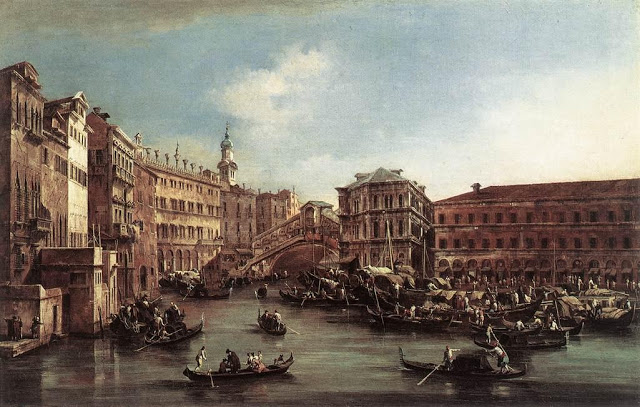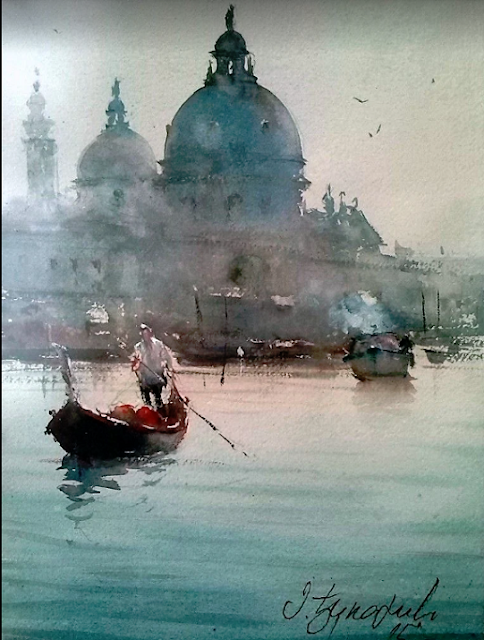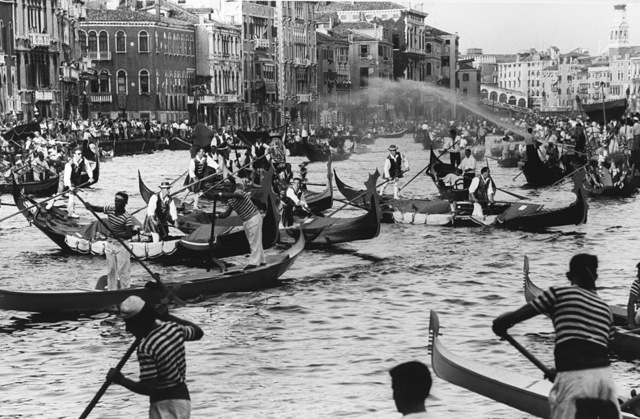01 Painting of the Canals of Venice by the artists of their time, with foot notes. #63
Francesco Guardi, (1712–1793)
The Rialto Bridge with the Palazzo dei Camerlenghi, circa 1763
Oil on canvas
Height: 60 cm (23.6 in). Width: 91 cm (35.8 in).
Private collection
Taking its vantage point from what is today the view from the Palazzo Sernagiotto, Guardi illustrates iconic landmarks of the Venetian landscape including the Palazzo Civran, the Fondaco dei Tedeschi, long famous for its murals by Giorgione and Titian, the Palazzo dei Camerlenghi, the Fruit Market and the supremely elegant Rialto Bridge itself, built in 1588–91 to the design of Antonio da Ponte. This was the spectacular scene that would have greeted tourists in the eighteenth century as they entered Venice from the south. Through his flickering delicacy of touch and masterful suffusing of colour, Guardi creates an expression of atmosphere like no other view painter of his time. More on this Painting
Francesco Lazzaro Guardi (October 5, 1712 – January 1, 1793) was an Italian painter of veduta, nobleman, and a member of the Venetian School. He is considered to be among the last practitioners of the classic Venetian school of painting.
In 1735, Guardi moved to the workshop of Michele Marieschi, where he remained until 1743. His first certain works are from 1738, for a parish at Vigo d'Anuania, in Trentino. In this period he worked alongside his older brother.
His works in this period included both landscapes and figure compositions. In 1763 he worked in Murano, in the church of San Pietro Martire, finishing a Miracle of a Dominican Saint.
Francesco Guardi's most important later works include the Doge's Feasts, a series of twelve canvases celebrating the ceremonies held in 1763 for the election of Doge Alvise IV Mocenigo. In circa 1778, he painted the severe Holy Trinity Appearing to Sts. Peter and Paul in the parish church of Roncegno.
In 1782 Guardi was commissioned by the Venetian government six canvases to celebrate the visit of the Russian Archdukes in the city, of which only two remain, and two others for that of Pope Pius VI. On September 12 of that year he was admitted to the Fine Art Academy of Venice.
Guardi died at Campiello de la Madona in Cannaregio (Venice) in 1793. More Francesco Lazzaro Guardi
Please note that the content of this post primarily consists of articles available from Wikipedia or other free sources online.
Please visit my other blogs: Art
Collector, Mythology, Marine
Art, Portrait of a Lady, The
Orientalist, Art of the Nude and The
Canals of Venice, And
visit my Boards on Pinterest
Images are copyright of their
respective owners, assignees or others. Some Images may be subject to copyright
I don't own any of these images -
credit is always given when due unless it is unknown to me. if I post your
images without your permission, please tell me.
I do not sell art, art prints, framed
posters or reproductions. Ads are shown only to compensate the hosting
expenses.
If you enjoyed this post, please share
with friends and family.
Thank you for visiting my blog and also
for liking its posts and pages.
Please note that the content of this post primarily consists of articles available from Wikipedia or other free sources online.



Comments
Post a Comment